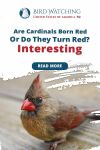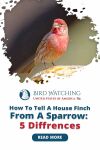
What’s This Post About?
Northern cardinals are one of the most attractive-looking songbirds of North America. The male cardinals have a bright red shade to them while the female cardinals are more of a brownish tone.
The color difference helps to differentiate the two genders of the northern cardinal species.
Female cardinals are responsible for building the nests, while the male cardinals defend the territory and raises the young after the female goes away to build a new nest.
Northern cardinals are all born with pink skin and gray scaling through which their internal veins are visible. Red shade or color is not prominent on the male or female hatchlings. The male cardinals grow red feathers as they molt and transition into an adult, while the female cardinals grow tan feathers.

What Are the Different Color Phases of Northern Cardinals?
Northern cardinals’ transition into different color tones till the time they reach adulthood.
Northern Cardinals grow and develop through different stages. When they are babies, they have a different tone to their body which then keeps changing as they move on to adulthood. The process of transition is known as molting.
The color stages with the age period of a cardinal are shown in the table below:
| Stage 1 | Hatchlings | 0 to 3 days old |
| Stage 2 | Nestlings | 4 to 13 days old |
| Stage 3 | Fledglings | 14 days and older |
At each step of growth, they change colors, and their body develops different tones and shades over time.
1. Babies

Northern cardinals at stage one (hatchlings) are born naked with a pink layer of skin and gray-toned scaling. At this point, no red color is prominent in the young. When the babies’ transition into nestlings, the molting phase begins.
During the molting phase, the baby cardinals develop a tan hue that remains with them till the next stage.
Not only the body but the beaks of baby cardinals that are black when they hatch turn into a faded coral red tint during the molting period.
Fun Fact
Post brooding, female cardinals perform the incubation and sing to the male if they need food. The male cardinals defend the nest and bring food for the female cardinal.
2. Molting

When the nestlings of northern cardinals’ progress into fledglings, they start to grow feathers. Juvenile northern cardinals usually grow feathers in the fall season. Their tan body slowly changes into light brownish-red tones.
The feathers formed on the wings and tails convert into a fainted red color for both male and female juveniles. Only the male northern cardinals show prominent red tones on their head and torso.
Female northern cardinals usually develop light brown and grayish feathers in these areas. The beaks of both genders develop black masks around them during the molting period.
Interesting Fact
Cardinals molt at least once a year to shed off damaged feathers, some cardinals go bald for a long period.
3. Female Adults

The female cardinals are different in color from male cardinals. When the young cardinals grow fully into adults, they change colors according to their gender.
Female cardinals do not form a bright red color, they are mostly brown and gray with soft red spots overall.
The similarity between both the genders is in the shape of their head and their stature. The red-tinted beaks and black masks are also one of the similarities in both the genders of northern cardinals.
Pro-Tip
To identify the gender of the cardinal, observe the color shades of the feathers. Females are mostly brownish while males are pure red.
4. Male Adults

The male northern cardinals have vibrant, red-coated bodies. The heads of male cardinals are covered with red feathers. Their coral-shaded beaks are surrounded by a black mask.
The shiny and bright red color differentiates them from all other songbirds. Some males might have brown spots on their wings and tails, but the dominant red tone is what makes these creatures attractive.
Interesting Fact
The colors that northern cardinals transform into is due to a pigment found naturally in plants. This pigment is known as carotenoids.
Why Are Northern Cardinals Red?
The red color on cardinals can be explained by scientific reasoning.

The northern cardinals and other, orange, red, or yellow birds get their color from the fruits and seeds that they consume. These fruits and seeds are rich in carotenoid pigments that are responsible for the red coloring of northern cardinals.
Cardinals cannot reflect the color unless they consume these carotenoid-rich substances which is why young cardinals are not born red.
According to scientists, northern cardinal’s bodies transform into red over time when they start consuming this pigment.
The Coloration Process
There are two types of mechanisms that take place to produce the red, orange, or yellow colored feathers in birds: pigments and structural properties.
These mechanisms combine to produce different colors and also produce separate colors on their own. Let’s discuss the processes in detail:
-
The structural features of the feathers found on the northern cardinals perform like microscopic prisms that scatter the light to give the red, orange or yellow shade to the feathers.
-
Pigments are different substances which the feathers absorb and reflect, depending on the wavelengths of light. The three main pigments that give cardinals their distinct colors are carotenoids, porphyrins, and melanin.
Interesting Fact
Cardinals are known as the winter red bird since they are non-migratory and are extremely noticeable against the white snowy outlook.
-
Carotenoids help produce bright red, yellow, or orange colors on the birds. If carotenoids mix with melanin, they may produce shades of olive green on the feathers of the birds.
-
Porphyrins emerge when amino acids are modified. They are rarely available and can produce pure colors such as browns, reds, greens, etc.
-
Melanin is similar to the pigments that give humans their skin color. Melanin can produce colors ranging from black to browns, tints of yellow or red. The shades may seem faded or mixed with other colors.
Carotenoid Pigments
Cardinals absorbs the carotenoid pigment from seeds, fruits, and plants that are rich with carotenoids.
The favorite food sources of cardinals that consist of this pigment are red berries from dogwood trees. To learn more about what northern cardinals like to eat you can read up on what do cardinals eat.
What do Cardinals Eat? Feed Them This to Attract Them!
Are you in search of the best feed that you can provide to attract Cardinals to your backyard? Read ahead to find out more about it.
When the cardinals metabolize these berries, the pigments within them are processed by the liver. From the liver, it is deposited through the bloodstream in growing feather follicles.
If the cardinals are not consuming enough carotenoid-rich food, the red color on their feathers becomes duller.
You can detect and identify cardinals and other red birds in your backyard with the help of a telescope and an informative bird guide.
Gosky 12x55 High Definition Monocular Telescope
12x55 high power magnification - have the best view in your outdoor adventures.
National Geographic Backyard Guide to the Birds of North America
Geared to the casual and experienced birdwatcher alike, this completely revised guide to 150 of the most common and interesting birds in North America provides the perfect way to appreciate the feathered friends outside your window, along with the tools you need to cultivate them wherever you live.
Pro-Tip
To attract northern cardinals to your backyard, you should focus on planting shrubs, flowers, and plants that the cardinals like to eat.
Keep Reading!
Cardinals are not just found in a bright red color; some cardinals have a white or yellow body. The white pigment may be due to the lack of melanin in their feathers, while the yellow pigment may be due to genetic mutation.
This post consists of all the important information, necessary to understand the color transformation in northern cardinals and the reason for it.
If you want to learn more about the different types of red birds found, you may read my post on birds with red heads.
13 Astounding Birds with Red Heads With Pictures! (Backyard Friendly)
Wondering what type of red-headed bird just fluttered by you in your backyard? It’s not as easy to figure out as you’d think. There are quite a few!

By David A. Swanson
Bird Watching USA
My name is David and I'm the the founder of Bird Watching USA! I started Bird Watching with My father-in-law many years ago, and I've become an addict to watching these beautiful creatures. I've learnt so much over about bird watching over the years that I want to share with the world everything I know about them!

David A. Swanson
Bird Watching USA
My name is David and I'm the the founder of Bird Watching USA! I started Bird Watching with My father-in-law many years ago, and I've become an addict to watching these beautiful creatures. I've learnt so much over about bird watching over the years that I want to share with the world everything I know about them!







![7 Cute Duck Breeds with Yellow Ducklings [24 Pictures!] Thumbnail](/assets/resized/img/posts/yellow-duckling-breeds-100x150.jpg)


![7 Cute Duck Breeds with Yellow Ducklings [24 Pictures!] Thumbnail](/assets/resized/img/posts/yellow-duckling-breeds_thumbnail-100x56.jpg)

